First snowfall. While winter doesn't start officially for two weeks, it felt like it came to Connecticut yesterday. Time to switch from the transitional dishes of fall, and jump full-fledged into the heavy, hearty dishes of winter. Time for Cassoulet!
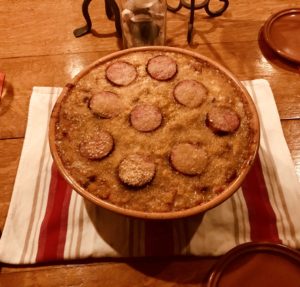
Pictured above is my finished Toulouse-Style Cassoulet, which I made from this online Food & Wine recipe by Paula Wolfert:
http://www.foodandwine.com/recipes/toulouse-style-cassoulet
Sourcing the Ingredients
It took several days of ingredient sourcing and cooking, but the end result was well worth the effort. This completes a trilogy of ambitious bean dishes, which I started with the Food Lab recipe for Best Short Rib Chilli, then went onto the Padovano/Oliver/Santos recipe for Brazilian Feijoada, and finally to this, the most complicated and unctuously rich of the three.
The Food & Wine recipe calls for Tarbais beans, a specialty of Toulouse, no less than seven cuts of pork (fresh hocks, pork skin, pork shoulder, salt pork, pancetta, prosciutto and a Toulouse fresh garlic sausage), plus duck confit, with the final stages of the Cassoulet to be cooked in a cassole, the conical casserole for which the dish is named. And to be served with a tannic red from Languedoc, the region of southwest France of which Toulouse is the capital. I decided to follow all of Wolfert's instructions to the letter.
I started sourcing the ingredients two weeks ago. I found a source of Tarbais beans online, grown by Rancho Gordo in Napa, California from French seed stock:
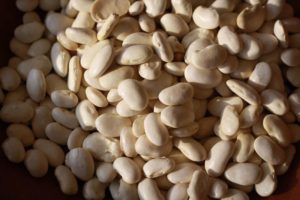
I sourced fresh duck confit online from D'Artagnan:

My brother called me yesterday while I was in the final stages of making the Cassoulet. He said he was on his way to the Salton Sea for some duck hunting. Ha! I said that duck was the common denominator of our two days, as I was about to add the duck confit to the Cassoulet. I mused that maybe next time I would prepare my own duck confit from scratch. He countered that if I really wanted to go all the way, I would come out and go duck hunting with him. Tempting, but I suspect those wild ducks are too lean to make confit, which requires that the duck be slowly cooked in its own fat, plus some added duck fat.
I was able to source the ham hocks, pork skin, pork shoulder, salt pork, pancetta and prosciutto from Cliff's Prime Cuts in Essex, which left just the fresh garlic sausage. Turns out that Fromage in Old Saybrook gets a shipment from New York every Tuesday morning of Saucisson d'Ail, the Toulouse-style fresh garlic sausage which is the last element added to the Cassoulet. Fromage also had the duck fat that I needed to brown the various cuts of pork. Now that I have the ability to grind my own meat and make my own sausages, and found a recipe online for this sausage, I think I'll make my own Saucisson d'Ail next time. Here's the sausage:

Step 1: Soaking the Beans and Salting the Hocks and the Shoulder
With all of the ingredients in hand, I started making the Cassoulet on Tuesday night, rinsing and covering the 2 lb of beans with 3 inches of water and soaking overnight:
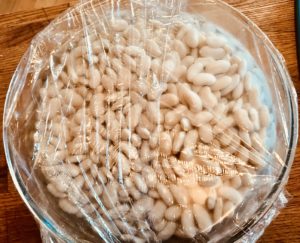
At the same time, I lightly seasoned with salt and pepper two fresh ham hocks, 1 lb of boneless pork shoulder cut into half-inch cubes and 6 oz of pork skin with 1/4 inch of fat attached, put them in a large dish and covered and refrigerated them overnight.
Step 2: Simmering the Skin and Salt Pork
The next day I simmered for 20 minutes the pork skin and 2 oz of salt pork, from which the skin had been removed:
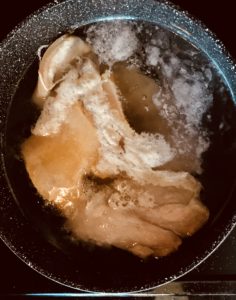
Step 4: Browning the Hocks, Shoulder, Pancetta and Prosciutto
While the salt pork and skin were simmering, I dried the hocks and pork shoulder cubes with a paper towel and then browned the cubes in 1/3 cup of duck fat:
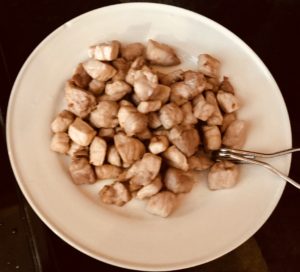
Then I browned the hocks in the same fat:
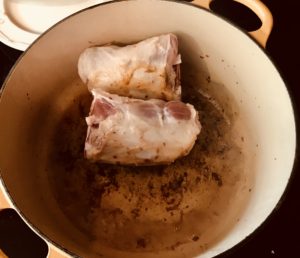
Then added 3 small, thinly-sliced carrots and 2 medium diced onions to the hocks and browned them for 7 minutes. Next up were these ingredients:
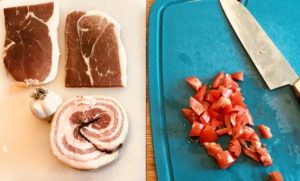
These are two thick slices of prosciutto totaling 5 oz, a 5 oz piece of pancetta, a whole unpeeled head of garlic and 1 large chopped plum tomato. I added the pancetta to the hocks and veggies and browned it lightly, then added the prosciutto, the head of garlic and the chopped tomato and cooked them for 1 min. Then I added 2 quarts of chicken broth, the pork skin, the browned pork shoulder cubes and a bouquet garni of 4 parley springs, 3 small celery ribs, 2 thyme sprigs and 1 bay leaf, tied with string.
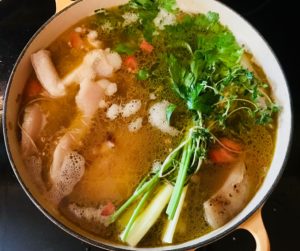
I brought this ragout to a boil and then simmered it for 1 1/2 hours.
Step 4: Adding the Beans
I drained the soaked beans and then covered with them with water in a large sauce pan, brought to a boil over moderate heat, simmered for 3 min and then drained them. I then added the beans to ragout and simmered until the beans were just tender, about 2 hours. Let the beans and ragout cool, then refrigerated it overnight.
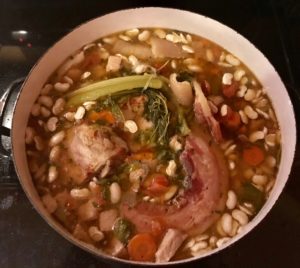
Step 5: Remove Fat from Top of Ragout, Debone and Chop Meat
The next day (this would now be Thursday), I skimmed the solidified fat from the top of the ragout to reserve for later use.
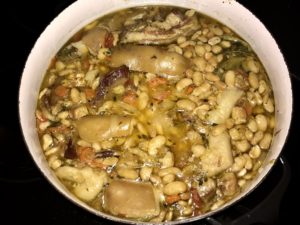
Removed and discarded the bouquet garni. Removed and reserved the head of garlic. Removed the hocks and cut the meat off the bone into bite size pieces. Removed the pancetta and prosciutto and cut into bite size pieces. Removed and reserved the pork skin.
Step 6: Make a Salt Pork/ Garlic Paste
Squeezed the head of garlic into a food processor, added 4 small cloves of uncooked garlic, and the salt pork cut into small pieces. Processed into a smooth paste, added to the ragout, simmered for 15 minutes, then added in all the cooked and cured meats. At this stage, the ragout can be covered and refrigerated for up to 3 three days. I left it this way for two days and went to the final steps on Saturday, when my friends Ron and Lois came over to be my Guinea Pigs.
Step 7: Roasting and Deboning the Duck Confit
Arranged the duck confit in a baking dish and roasted for 15 min in a 400F oven, then removed the meat from the bone in large pieces and cut the skin into strips.
Step 8: A First Cooking of the Beans and Duck
Arranged the pork skin, fat side down in the bottom of a 6-8 quart earthenware casserole dish, put half of the bean ragout on top of the skin, then layered the duck confit on top of the bean ragout, and then layered the remainder of the bean ragout on top of the duck. Drizzled with a couple T of the reserved fat from Day 2 and baked in a 325F oven for 1 1/2 hours.
Step 9: Browning the Sausages
Browned the sausage in 1 T vegetable oil over moderately high heat. Allowed to cool. Then cut into slices.
Step 10: A Second Cooking of the Completed Cassoulet with the Sausages
Gently stirred in the crust that formed on top of the beans, nestled in the sausage slices, drizzled with 2 T of the reserved fat, sprinkled with 1/4 cup of fresh bread crumbs, and baked in a 275 oven for another hour, until it was richly browned on the surface. Placed on a cloth-lined rack and allowed to rest for at least 20 minutes before serving. Here is the completed Cassoulet resting:
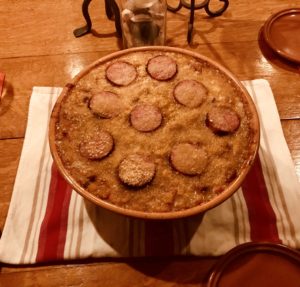
I served the Cassoulet with a simple salad of Boston lettuce:
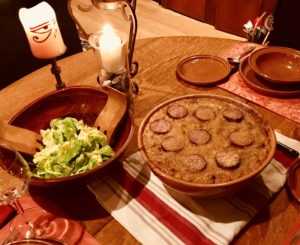
My friends Ron and Lois arrived shortly after this picture was taken with a fresh baguette and a Languedoc red. Since this was such an elaborate adventure in the making of it, I decided to give the Cassoulet a fitting setting by lighting all the candles:
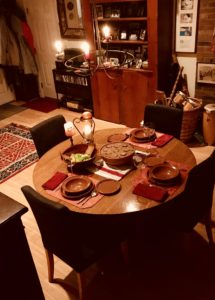
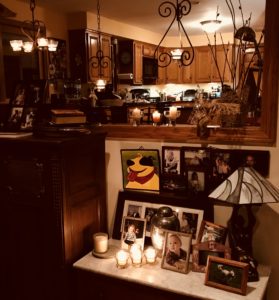
It was awesome!
And there was a lot left over. In fact, I couldn't even fit all of the bean ragout into the largest earthenware casserole I have, which holds about 6 quarts or so. So today I made another batch in the small cassole I bought from Maine Kiln Works. I thought I was buying a 6 quart cassole, but it turned out to be a 6 cup one (remember the Stonehenge in Spinal Tap?). Here it is, filled with the extra bean ragout and duck confit, ready to start the two-stage, 2 1/2-hour final cooking process. I took the picture so you could see its inverted conical shape, which is designed to maximize the size of the top crust:
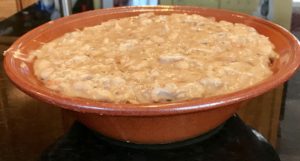
Here is the finished Cassoulet. Even better crust than the first one:
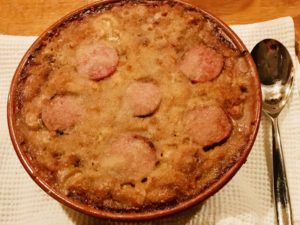
My friend Rod was the Guinea Pig for this batch. Loved it.
Now all I need is about 12 more friends to help me with the leftovers from this batch and the first one.
